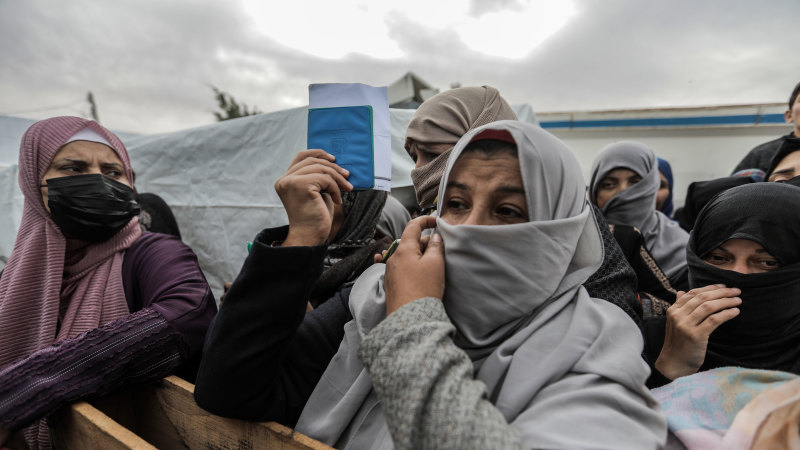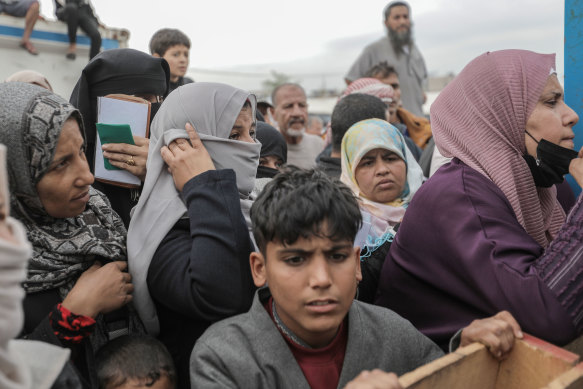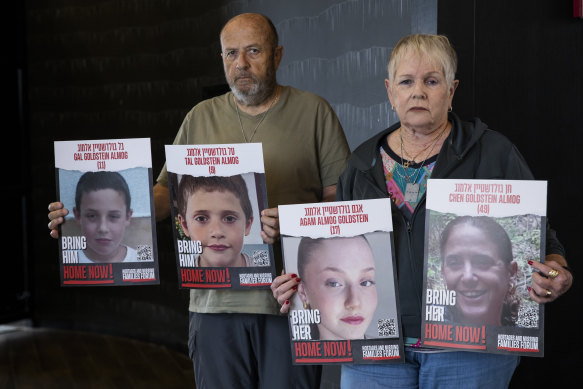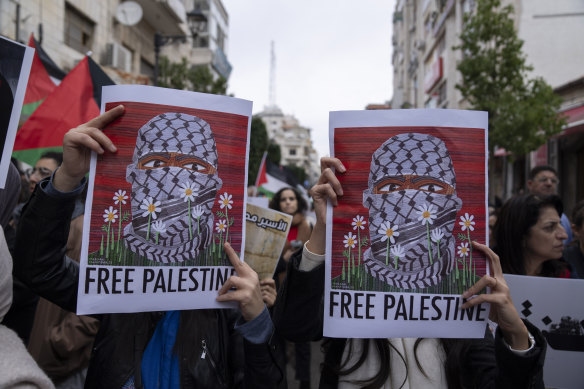Save articles for later
Add articles to your saved list and come back to them any time.
Gaza/Jerusalem: Dozens of Palestinian women and teenagers held prisoner by Israel for periods of a few months to several years will gain their freedom under the deal for the release of 50 Israeli hostages held in Gaza by the Islamist group Hamas agreed to on Wednesday (AEDT).
Jubilant reunions are expected when Palestinian families greet the prisoners on their return as early as Thursday (Israel time), most of them to their homes in the occupied West Bank and Jerusalem.
UNRWA distributes flour to Palestinian refugees on November in Khan Yunis, Gaza. Credit: Getty
Arrested for such offences as attempted stabbings, stone throwings at Israeli soldiers or having contacts with hostile organisations, many were held under administrative detention, meaning Israel held them without trial.
In contrast to previous prisoner swaps, notably the deal under which Israeli soldier Gilad Shalit was released by Hamas in 2011, none has been convicted of murdering Israelis.
In that deal, Israel released more than 1000 prisoners, some convicted of murder, including Yahya Sinwar, the Hamas leader in the Gaza Strip and one of those held responsible by Israel for a deadly Oct. 7 Hamas assault on Israel.
The Qatari-brokered accord was the first concrete sign of any halt to the fighting which began with the Oct. 7 attack by hundreds of Hamas gunmen, who seized around 240 Israelis and foreigners as hostages.
David and Varda Goldstein pose for a picture while holding-up photos of their 3 grandchildren, Gal, Tal and Agam, and their mother, Chen, who were kidnapped on October 7th.Credit: Getty
Israel said the ceasefire could be extended further if more hostages were freed, and a Palestinian source said as many as 100 hostages in total could be released by the end of the month.
Hamas and allied groups captured around 240 hostages when Islamist gunmen rampaged through southern Israeli towns on October 7. Previously, Hamas had released just four.
The truce was not expected to begin until Thursday morning (Israel time), and the start time had yet to be officially announced as of Wednesday afternoon.
A statement by Israeli Prime Minister Benjamin Netanyahu’s office on Tuesday night said 50 women and children would be released over four days at a rate of at least 10 daily. Beyond that, the truce could be extended day by day as long as an additional 10 hostages were freed per day.
Palestinian protesters carry posters and chant anti Israel slogans during a rally in solidarity with Gaza, in the West Bank city of Ramallah.Credit: AP
Israel’s justice ministry published a list of 300 names of Palestinian prisoners who could be freed.
“Israel’s government is committed to return all the hostages home. Tonight, it approved the proposed deal as a first stage to achieving this goal,” said the government statement.
Hamas said the initial 50 hostages would be released in exchange for 150 Palestinian women and children imprisoned in Israel. Hundreds of trucks of humanitarian, medical and fuel supplies would enter Gaza, while Israel would halt all air sorties over southern Gaza and maintain a daily six-hour daytime no-fly window in the north, the enclave’s ruling Islamists said.
Israel has subjected Gaza to siege and relentless bombardment since the Hamas attack, which killed 1200 people, mostly civilians, according to Israeli tallies. Since then, over 14,000 Gazans have been killed, around 40 per cent of them children, according to medical officials in the territory.
Terms of the Israel-Hamas ceasefire
- All fighting in Gaza halts for four days.
- Hamas will release 50 women and children held as hostages.
- In exchange Israel will release 150 Palestinian women and children from jail.
- The truce deal will allow hundreds of trucks of humanitarian, medical and fuel aid to enter Gaza.
- Israel to extend truce an extra day for every additional 10 hostages released by Hamas.
Qatar’s chief negotiator in ceasefire talks, Minister of State at the Foreign Ministry Mohammed Al-Khulaifi, told Reuters the truce meant there would be “no attack whatsoever. No military movements, no expansion, nothing”.
Qatar hopes the deal “will be a seed to a bigger agreement and a permanent cease of fire…That’s our intention,” he said.
The truce deal is a first small step towards peace in the most violent ruction of the 75-year-old Palestinian-Israeli conflict. The past seven weeks have shocked the world because of the suffering of civilians on both sides, beginning with the killing of Israeli families in their homes and continuing with destruction rained down on Gaza, home to 2.3 million people.
“What truce can there be after what happened to us? We are all are dead people,” said Mona, a woman in Gaza whose nieces and nephews were among those killed by an Israeli air strike that hit the home of the Seyam family.
“This will not bring back what we lost, will not heal our hearts or make up for the tears we shed.”
US President Joe Biden was among international leaders who welcomed the deal.
Three Americans, including a 3-year-old girl whose parents were killed on October 7, are expected to be among the hostages to be released, a senior US official said.
More coverage of the Hamas-Israel conflict
- Hamas had bigger plans on October 7: Intelligence about Hamas’ motivations reveals an intention to strike a blow of historic proportions and provoke an overwhelming Israeli response.
- Escape from chaos: An Australian father faced a heartbreaking dilemma – whether to flee Gaza to his children, or stay with his wife.
- Open letters: Mass resignations, boardroom turmoil and angry donors are some of the ways the Israel-Hamas war is filtering down into Australia’s high-powered arts world.
- Gaza’s youth: One of the cruellest ironies of war is that they are never started by children, yet it is children who suffer the most.
Get a note directly from our foreign correspondents on what’s making headlines around the world. Sign up for our weekly What in the World newsletter.
Reuters
Most Viewed in World
From our partners
Source: Read Full Article



